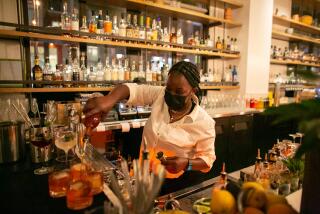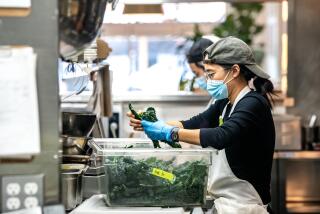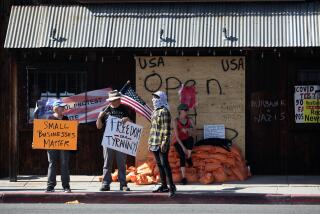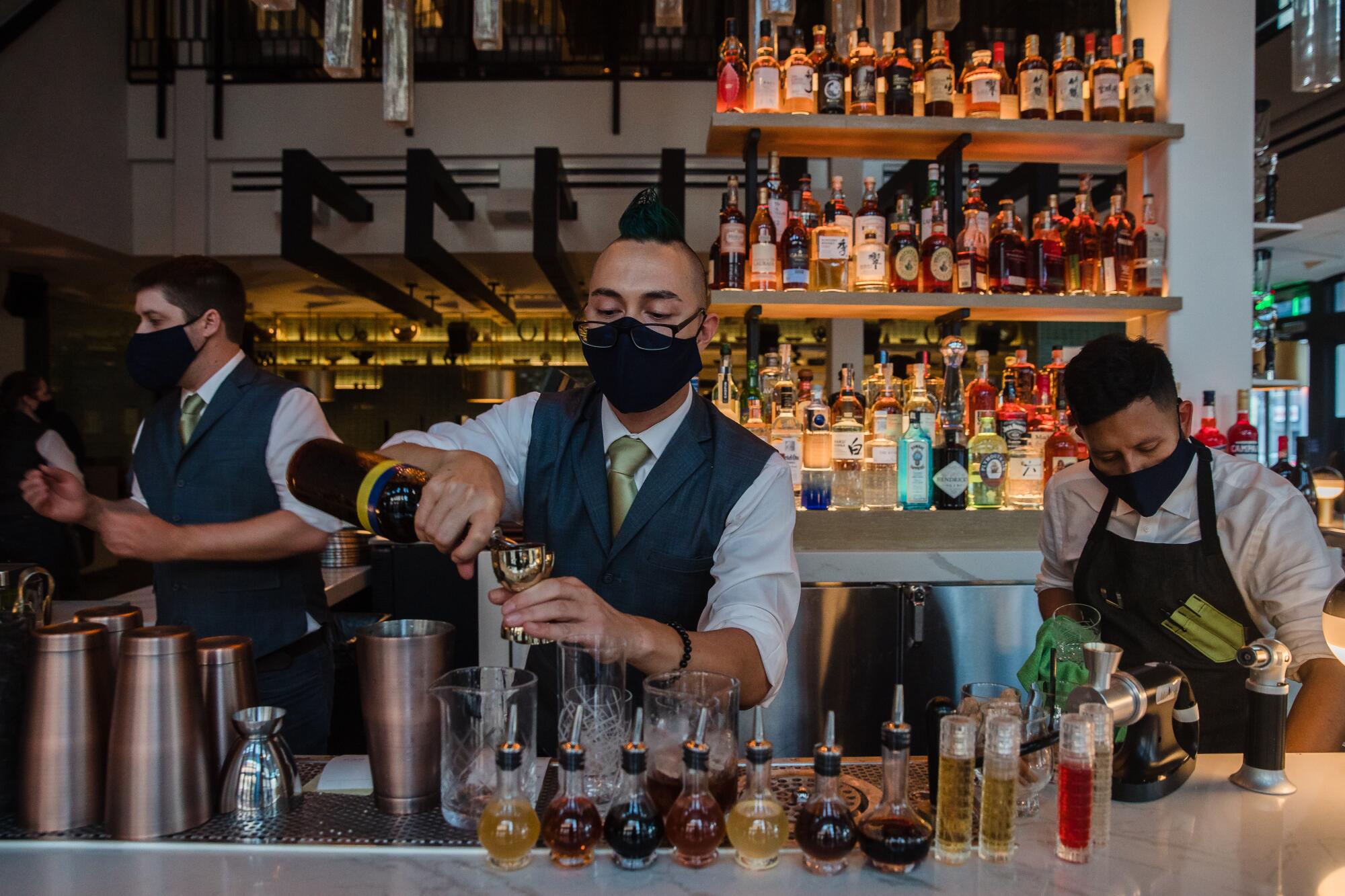
With continued surges in the coronavirus, San Diegoâs hospitality industry could soon be facing an indoor dining ban.
SAN DIEGO â As Mike Georgopoulos was prepping this week to finally open his swanky $10-million steakhouse in the Gaslamp Quarter, he stared down from his perch on the mezzanine with a mixture of delight â and dread. The floor-to-ceiling wine display and marble bar top were dazzling, and the wait staff, nattily attired in black pants, pressed white shirts, gray vests and green ties, meticulously polished the glassware for the Friday opening.
But why bother opening at all, he wondered.
Just hours earlier, county officials had warned of the looming threat this week of a ban on all indoor dining and drinking, which 19 California counties, including Los Angeles and Orange, have already been ordered to implement for the next three weeks. With an alarming surge in coronavirus cases, San Diego could be next, the county said.
âHere we are, getting ready for a dress rehearsal and we already just lost our late-night hours, and now we may be losing indoor dining altogether, so do we pull the plug, but we canât because all these employees came back,â fretted Georgopoulos, a seasoned nightlife and restaurant operator and partner with the RMD Group, which has seven San Diego venues, including his new Huntress steakhouse. âWe wonât make any money, thatâs for sure, we just do it because itâs the right thing to do for our staff and customers.
âItâs the uncertainty, thatâs the theme of this whole thing,â
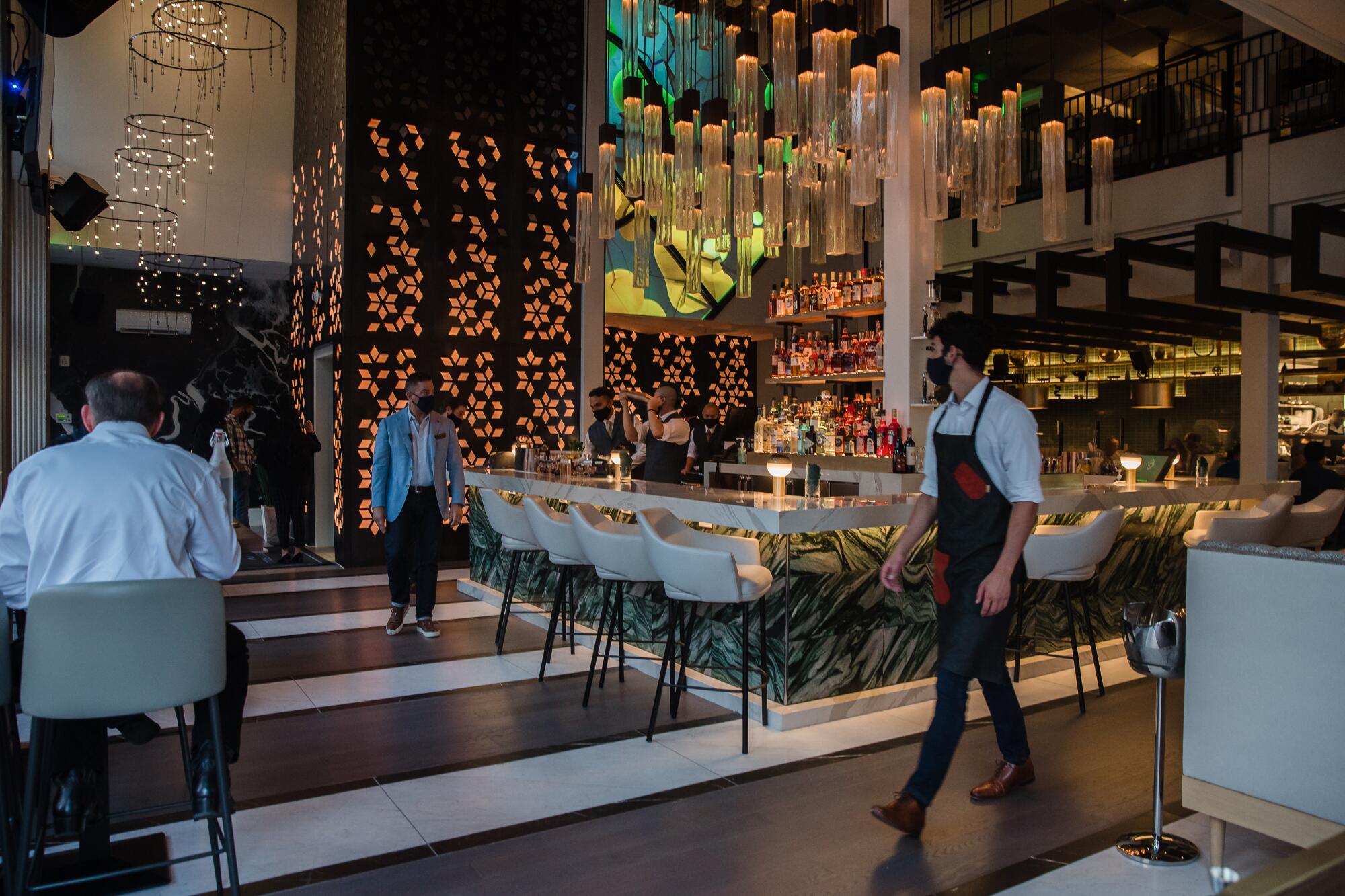
As the coronavirusâ spread has ensnared increasing numbers of young people in the last few weeks, health officials have deduced that dining out and drinking at recently reopened restaurants and bars may be partly to blame, despite the businessesâ best efforts to control the virusâ spread with plexiglass barriers, constant sanitation and repeated reminders to remain 6 feet apart. Restaurants and bars have also consistently led the list of widening COVID community outbreak locations that have troubled public health officials.
The result has been a set of on-again, off-again reopening and closing orders that have thrown hospitality owners â and their employees â into an emotional and financial tailspin.
In an industry that already has to contend with the thinnest of profit margins, the uncertainty associated with the coronavirusâ capricious nature has raised questions in the minds of operators of how much longer they can survive as the infection rates show no signs of slowing. Confined spaces with now limited seating due to social distancing guidelines and a bar culture that encourages mingling make it that much harder to turn a profit, much less break even.
And many neighborhood bars and eateries donât have the luxury of ample patio seating, which would still be allowed should indoor service be shut down in the coming week.
âWeâre getting destroyed,â said Chad Cline, co-owner of the Waterfront Bar & Grill in Little Italy and a number of other nightlife venues, including the Aero Club. Business at the Waterfront, a densely packed watering hole in normal times, had already been down about 50% because of the mandate to seat customers six feet apart. And with a recent directive to nix late-night operations, an additional 30% in business has evaporated, he estimates.
âIn the past month we just wanted to not sink as fast, and now theyâve given us lead weight belts, so weâre in this constant state of sinking. I get there are these experts making these recommendations but my issue is if a certain industry bears the burden for societyâs safety, society should be helping with that burden financially.â
A raft of bad news
This week was an especially sobering one for restaurant and bar operators who just weeks ago began navigating a post-pandemic world of sharply reduced occupancies. On Monday, local bars learned they would have to cease operating unless they started selling food with their drink orders. A day later, restaurants and those bars that could stay open were told theyâd have to close every night by 10 p.m., effectively killing the late-night business that is the lifeblood of nightlife destinations like downtown and the beach areas.
And by Wednesday, the news was even grimmer. The growing number of COVID cases per capita in the county was dangerously close to triggering Gov. Gavin Newsomâs restrictions limiting dining to outdoors only. An explosion of cases and outbreaks reported Thursday only solidified the likelihood of a rollback of reopenings this week.
County Board of Supervisors Chairman Greg Cox has been blunt in his assessment of why stricter measures have had to be taken, as much as it hurts local businesses.
âWeâve taken these steps to target the growing outbreaks in social settings and the rise in cases of young people who are going out more and letting their guard down, which is adding to the spread of this virus,â he said during a Wednesday news conference. âIf your car is speeding down the road toward a cliff, you hit the brakes. We are hitting the brakes to avoid going over that cliff.â
A hard stop on indoor dining and drinking will take an especially large toll on a sector of the economy that last year generated sales of more than $7.3 billion in San Diego County. While more restaurant and bar employees were returning to work in June, there were 56,000 fewer such jobs in May than a year earlier, said San Diego economist Kelly Cunningham.
There is a sizable cost, lament restaurateurs, that comes with opening a previously closed business, shutting it down and yet again reopening it. And thereâs also the nagging issue of bringing back employees to an uncertain future.
Georgopoulos estimates he spent $42,000 on just the COVID-related expenses of opening the Huntress, from training workers and marketing to extensive plexiglass barriers. A day before his grand opening, he decided to put on hold the debut of the steakhouse but on Friday opened the first floor and patio of the multi-level space, limiting the menu to âelevated bar bitesâ and cocktails. Across all of his venues, he estimates his sales are between 35 and 40% of what they were this time last year.
Restaurateur Arsalun Tafazoli of CH Projects reopened his tony Born & Raised steakhouse in Little Italy just a week ago. To have to close it next week would mean the loss of as much as $100,000 in food, much of that the restaurantâs signature dry-aged beef. Heâs already decided to postpone the planned reopening of his glam cocktail bar, Raised By Wolves in Westfield UTC, because of the likely order to halt indoor imbibing. In the meantime, heâs already brought back about half his staff.
âItâs become constant anxiety and stress, and those who can adapt and be nimble quickly can sustain their businesses but there are a lot of us who canât,â said Tafazoli, who has only reopened a few of his 16 dining and drinking venues. âThis virus is going to be with us for a while and if we canât coexist in a consistent way, our industry is going to slowly decay and wither away.â
Unemployment looms again
As stressful as the constant state of flux is for business owners, itâs even harder for employees, who are just venturing back to work after receiving steady unemployment pay, says Chris Shaw, a co-owner of Urban Moâs, a popular gay bar and restaurant, as well as several other venues in Hillcrest. Should there be a county halt to indoor dining, itâs likely the ownership would have to close most of its locations because there wouldnât be enough business, even with outdoor dining space, to cover the high cost of keeping a restaurant open, Shaw said.
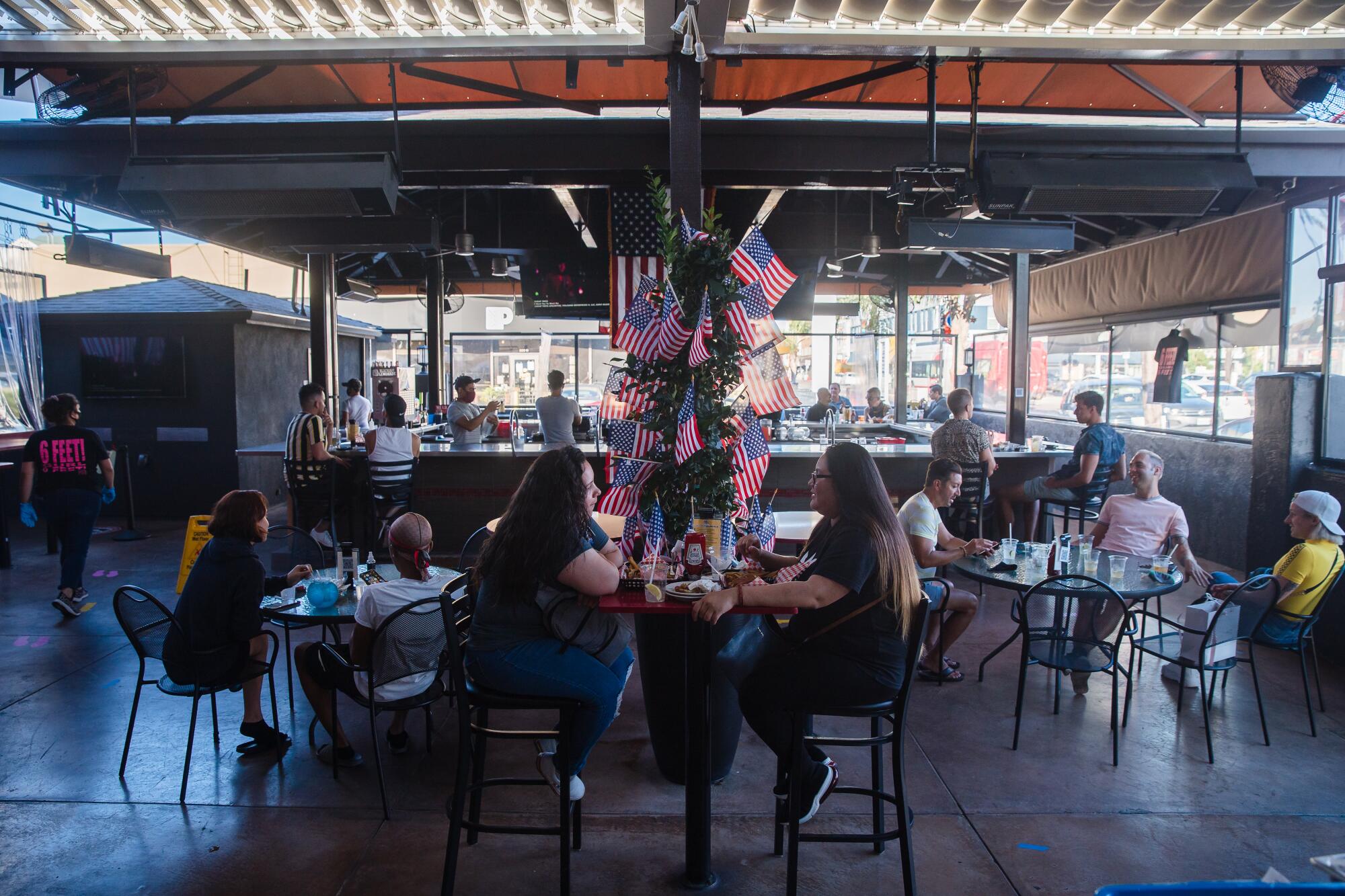
Urban Moâs, he said, is normally a $6-million-a-year business. With the current restrictions, thatâs been cut in half. To close indoor dining would shave an additional $1 million off its revenue over a yearâs time, Shaw estimates.
âItâs hard on us in terms of the income loss but the hardest part is on the staff who have to refile for unemployment,â said Shaw, who estimates his federal loan assistance will run out by early September. âOne-third of our employees will be put back on furlough because thereâs not enough business to warrant that much staff.â
The pandemic has been an equal opportunity foe, hitting large and small players equally hard.
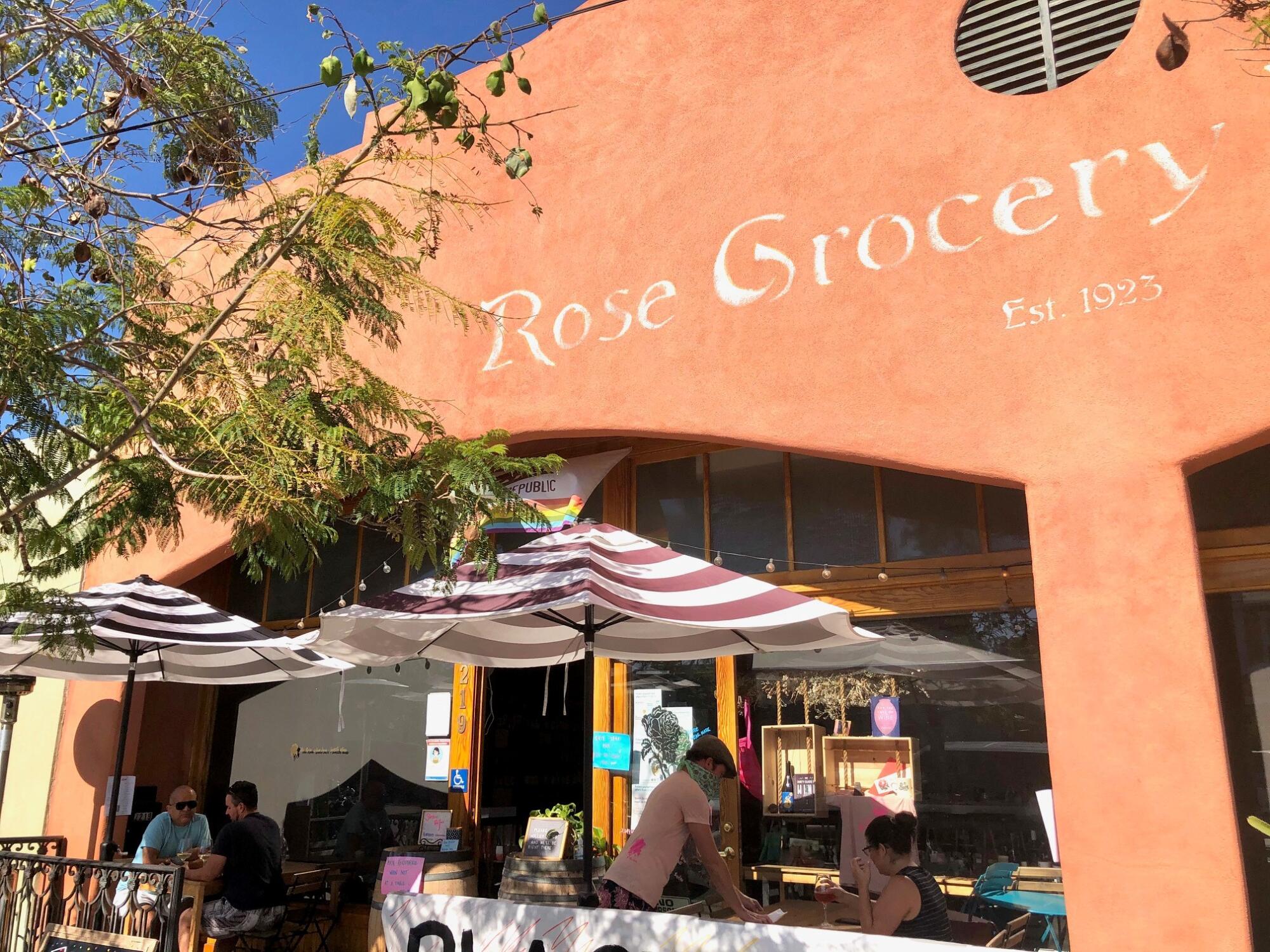
Tuesday marks the sixth anniversary of the Rose, a 50-seat wine bar and bottle shop in South Park, but co-founders Chelsea Coleman and Rae Gurne havenât found much to celebrate over the past few months.
Not only has the pandemic slashed profits for the Rose, it has also jeopardized the future of the business partnersâ long-anticipated second venture, Mabelâs Gone Fishing, an oyster and gin bar in North Park. Named after Colemanâs dog, Mabelâs was supposed to open this summer, but it may no longer be a viable business in the current economic climate.
âWhatâs been hardest on me and Rae,â Coleman said, âis we felt like we were finally at the point where we could expand and then the pandemic hit and weâre back at square one again.â
They had originally felt confident enough in their business plan for Mabelâs that they leased the space early this year and started construction. Now theyâre not sure whether the project will pencil out.
âWeâre stalling and trying to figure it out.â
âJust wear the masksâ
Bar Pink in North Park, which has yet to reopen since the mid-March shutdown, also has an upcoming anniversary, which its owners were hoping to celebrate next month: the barâs 13th year in business. But that celebration is now on hold, says co-owner Robin Chiki, given the likely reversal of reopening orders. It was her fear from the beginning, and it gives her no pleasure to say I told you so.
âWe had ordered floor stickers and were looking at ordering plexiglass, but itâs not as urgent now,â said Chiki, who has a forgivable Paycheck Protection loan from the federal government, plus a Small Business Administration loan that the bar will have to repay. âFingers crossed, we can survive. All we can do is sit here and wait and hopefully we can make some money to pay this money back.
âI say, Just wear the masks and believe in science, dammit.â
The wearing of facial coverings has become a politically divisive issue not just across the country but in local dining rooms as owners and managers confront a contingent of patrons unwilling to wear masks.
âWe either get, âI canât believe youâre making us wear masks, youâre stupid for asking us to do this,â or âI canât believe youâre trying to make money by opening when you shouldnât,ââ said Cline of the Waterfront. âThatâs not our brand, to just piss everyone off.â
Itâs difficult to know precisely how many businesses here are compliant when it comes to enforcing social distancing rules and the wearing of masks. Los Angeles County has released precise figures based on inspections while San Diego County has not.
In a Los Angeles Times report earlier this week, L.A. County officials reported that 49% of bars and 33% of restaurants were not adhering to social distancing protocols in the prior week. In addition, inspectors found that workers at 54% of bars and 44% of restaurants were not wearing face masks or shields.
In San Diego County, the Department of Environmental Health has conducted nearly 5,600 site visits to food facilities throughout the region and âhave observed the majority to be compliant,â county spokesman Mike Workman said. When asked during a press conference last week if the county could provide more specific percentages, Dr. Wilma Wooten, the countyâs public health officer, said she would have to check with Environmental Health officials.
Keeping up with the ever-changing guidelines has been an exhausting task, made even more challenging by some patronsâ resistance to adhering to county and state mandates, says Chris Cox, chief operating officer for OMG Hospitality, whose properties include Union Kitchen & Tap restaurant/bars in Encinitas and the Gaslamp Quarter and three spots in Pacific Beach: Backyard Kitchen & Tap, P.B. Alehouse and Waterbar.
Cox said the barrage of new rules has led not only to staff fatigue but also customer confrontations. Some patrons refuse to wear face coverings and others object to rules that require them to stay seated at tables when they drink. Some employees would rather stay on unemployment than work under those conditions, Cox said.
âTypically bars and restaurants are a form of escapism for the public, but they have also become a battleground for political divisiveness,â he said. âYouâre asking employees to deal with a very different environment than theyâre used to. Then you add in people trying to take their political beliefs to the extreme by threatening violence against employees.
âItâs been hard for employee morale and our customers. We want to stay active and keep the momentum going. Weâll do whatever we can do to survive.â
More to Read
Sign up for Essential California
The most important California stories and recommendations in your inbox every morning.
You may occasionally receive promotional content from the Los Angeles Times.
